![]()
![]()
![]()
Use LEFT and RIGHT arrow keys to navigate between flashcards;
Use UP and DOWN arrow keys to flip the card;
H to show hint;
A reads text to speech;
47 Cards in this Set
- Front
- Back
- 3rd side (hint)
|
Why organizations need to assess performance? (6)
|
1. Employees need to understand the behavior requirements of the job.
2. Employee’s work is evaluated for its contribution to company goals. 3. Employees receive feedback on their contribution to company goals. 4. Employees’ motivation is increased by the performance appraisal system. 5. Employees’ performance levels should be used to make decisions about salaries, promotions, bonuses, training needs, etc. 6. Employees get clear feedback on the level of performance expectations from the company |
|
|
|
Define Validity
|
the quality of the measuring components of the performance appraisal system (do they measure what they should?).
|
|
|
|
Define Consistency
|
two or more ways to gather performance data producing results which agree
|
|
|
|
Define stability
|
the property of dependability of results over time
|
|
|
|
PA errors
|
Personal bias, halo, recency, central tendency, strictness/leniency, similarity, forcing to match.
|
|
|
|
• Personal bias
|
: a stereotype or bias which influences a supervisor’s rating upward of downward.
|
|
|
|
• Halo effect
|
rating an employee on one performance dimension based on the evaluation in other performance dimensions
|
|
|
|
• Recency Error
|
the emphasis on recent performance examples in making performance assessments
|
|
|
|
• Central tendency error:
|
Assigning average ratings to all employees resulting in little variation
|
|
|
|
• Strictness or leniency errors
|
Supervisor’s ratings based on the belief the employees do not measure up or that all employees measure up
|
|
|
|
• Similarity error
|
the supervisor has a performance quality in himself that she is looking for in the employees
|
|
|
|
• Forcing the rating to match other criteria:
|
Deciding on an overall rating first and then going back to individual dimensions to adjust ratings to match overall assessment
|
|
|
|
5 forms of validity (CECCD)
|
Content, Empirical, Construct, Convergent, discriminant
|
|
|
|
• Content validity
|
measures and their administration are logically related to the performance measured; evaluator and employees agree on the dimensions of performance measured and relationship to actual job behaviors.
|
|
|
|
• Empirical validity
|
measures are statistically related to work outcomes. Scores on the performance dimensions are related to quantitative measures of work output
|
|
|
|
• Construct validity
|
performance appraisal system logically derives from a model or theory of performance behavior and motivation.
|
|
|
|
• Convergent validity
|
Multiple measures of the same performance dimension result in equivalent scores. Observation methods correlate highly with paper and pencil measures of performance.
|
|
|
|
• Disciminant validity
|
Measures of performance using the same method produce different scores for different performance
|
|
|
|
How to overcome errors in performance appraisal systems (4 ways):
|
1. Use multiple criteria
2. Emphasize behavior rather than traits 3. Use several raters (e.g. 360 degree reviews) 4. Train the raters |
|
|
|
PA Methods
|
Absolute Standards, Graphic Scales Rating System, Behavior Anchored Rating Scale (BARS)
|
|
|
|
• Absolute Standards
|
Each employee is judged against a fixed and inflexible set of performance criteria. Often results in upward biased ratings due to leniency error and validity error due to the simple ‘meets/does not meet’ nature of the assessment on the standards.
|
|
|
|
• Graphic Scales Rating System
|
List of performance criteria are evaluated on a numerical scale. The ratings highlight differences in the performance of subordinates as it encourages the tendency to spread out employee’s assessment across each scale. Inaccuracies due to strictness, leniency or similarity are still possible. Forced distribution across the full scale might lead to (perceived) unfair evaluations.
|
|
|
|
• Behavior Anchored Rating Scale (BARS):
|
BARS emphasizes work behavior and how the work gets done rather than characteristics of an employee. Through a participatory analysis a meaningful and agreed upon set of behavioral anchors described in the language of the job under evaluation are developed. The clarity of the behaviors improves employees’ understanding of the job and performance expectations. The strong behavioral focus of the BARS system:
• might help to avoid the evaluation of irrelevant employee’s personality traits • might increase the quality of the feedback compared to other systems • might enhance the significance of the feedback in the employee’s minds through reduced defensiveness • might require a long time to develop as different roles will require different BARS • might be difficult to develop for jobs requiring creativity, curiosity, and complex problem-solving. |
|
|
|
Goals are defined as
|
as those end states that reduce the intensity of needs and motives
|
|
|
|
What do Goal setting systems accomplish?
|
• Increase motivation and performance
• Reduce the stress of conflicting or confusing expectations • Improve accuracy and validity of performance evaluations |

|
|
|
Organisations must
evaluate employee performance to ensure that employees: (5) |
1. understand their job requirements.
2. contributions to company goals are evaluated. 3. know where they stand in relation to company performance standards. 4. continue to work hard because they think the system is fair and objective. 5. agree that their performance fairly and objectively determines their pay rises and bonuses: what is called merit-based pay. |
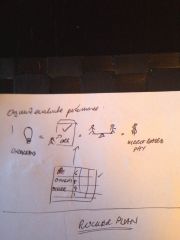
|
|
|
Define Intrinsic rewards
|
are defined as those rewards that the employee associates with the job itself.
|
|
|
|
Extrinsic rewards
|
are given to the employee by the company and they do not occur as the work unfolds. Extrinsic rewards can be classified as direct compensation, indirect compensation, and non-financial rewards.
|
|
|
|
On what basis do companies distribute direct compensation? (5)
|
1. Performance
2. Effort (in the hope that effort will eventually lead to performance) 3. Seniority 4. Equality (common in partnerships for managing partners) 5. Power and Influence |
|
|
|
What determines the value of a job to the company?
|
1. Skill requirements
2. Mental requirement 3. Physical requirement 4. Responsibility 5. Working Conditions |
|
|
|
Basic components of Executive Compensation:
|
• Base salary
• Benefits • Long-term incentives • Annual bonus |
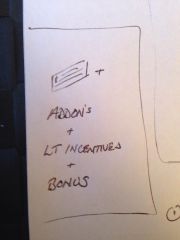
|
|
|
Current trends in executive compensation: (6)
|
• Strengthening the link between executive compensation and the market value of firms
• Executive compensation rises faster than employee wages • CEO pay rises much faster that the pay of the second in command • Pay gaps between American and British executives narrow • More emphasis on the company’s net income • Preventing ISO plans from diluting stock value |
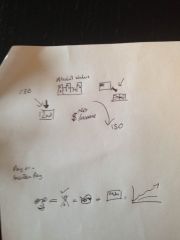
|
|
|
Any pay or incentive plan should pass the following five tests:
|
1. Does the plan capture the attention of the employees?
2. Do employees understand the elements of the plan? 3. Does the plan improve communication? 4. Does the plan make payments to the employees when it should? 5. Is the company performing better as a result of the plan? |
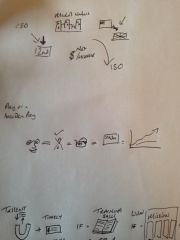
|
|
|
Cafeteria style fringe benefits
|
Creates balance between family needs and benefits package
Installation cost and administration are increasingly outsourced |
|
|
|
Lump-sum payments
|
Nice to earn a large bonus but might not be clear what he/she did to earn it.
Likely to be abandoned during downturns, can upset shareholders |
|
|
|
Skill-based compensation
|
Good incentive for learning new skills
Works if skills are measurable, documented and verified. Should not be tied to external educational or management training program achievements |
|
|
|
Accumulating time-off
|
Helps family, work, child, and elder care demands on employees Strengthens commitment and loyalty. Harder to implement in self-directed teams.
|
|
|
|
The all-salaried team
|
Workable if team performance is fairly measured and teams are empowered Easier to implement if union influence is declining. Validity of team appraisal system must be high.
|
|
|
|
Open salary information
|
Greater perceived pay equity and job satisfaction with work and supervision Computer based and outsourced control systems make implementation easy. Requires stable pay brackets and market based, fair starting salaries.
|
|
|
|
Gain-sharing plans (also called Scanlon Plans)
|
Group based reward system - links bonuses to work units/ team labour cost savings. For implementation 1. Dependable labour costs. 2. Limited seasonal demand. 3. Market Able to absorb extra output. 4. History labour-management relationship. 5. Number people critical. 6. Only if supports business strategy.
|
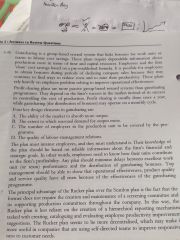
|
|
|
A well designed team based rewards system can strengthen an organization in the following ways: (6)
|
1. Attraction of new skilled employees and retention of existing ones
2. Timely and attractive incentives increase employee’s motivation and performance 3. If rewards are tied to cross-training and skill-building, the team members will acquire the necessary skills and make the workforce of the company more flexible and gain a competitive advantage. 4. Linking incentives to corporate values creates an organizational culture that competitors will have a hard time copying. 5. Reinforcement and definition of structure. E.g. usage of stock option incentives for every employee in a de-layered organization. 6. Since cost is to a large extend driven by incentives, the structure of incentives needs to be driven by the company’s strategic advantages. |
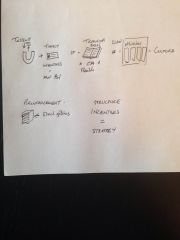
|
|
|
In a Rucker Plan the measurement of productivity used for incentives is called
|
value added.
|
|
|
|
Value added
|
is the difference between sales income from goods produced and the cost of the materials, supplies, and outside services consumed in the production and delivery of that output
|
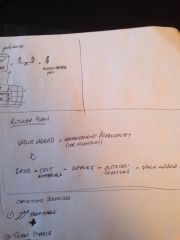
|
|
|
If a firm has downsized, the following conditions should be met before a gain-sharing or Rucker plan is introduced:
|
• The firm has returned to profitability and no further wage freezes are planned
• The management tem is stable. • Self-directed teams are working and members have completed training in TQM, process control, and team building. • The company is not being positioned for a sale or a spin-off. • Outsourcing of non-essential functions has been completed • The firm is using service-driven and market-based measures of customer satisfaction |
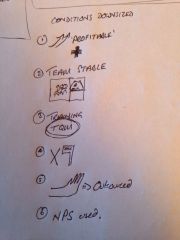
|
|
|
Actual and measured performance
|
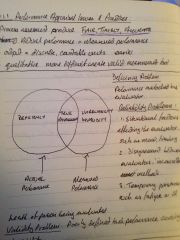
|
|
|
|
Job Analysis does?
|
Improves content and empirical validity of PA system. - Creates job descriptions, employee understands requirements - line of sight. Comms for new employees, hiring and training. Also highlights interdependencies of areas.
|
|
|
|
Goal Setting Process
|
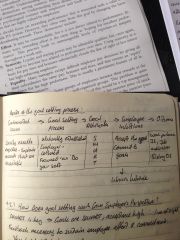
|
|

